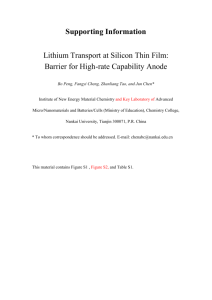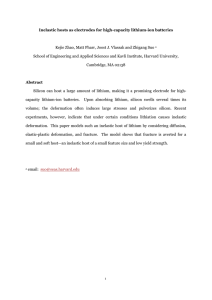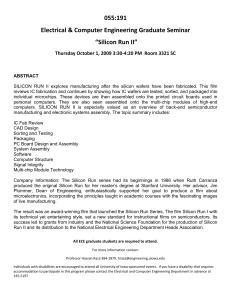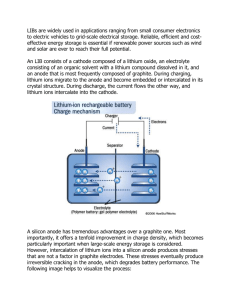Inelastic hosts as electrodes for high-capacity lithium-ion batteries Suo
advertisement
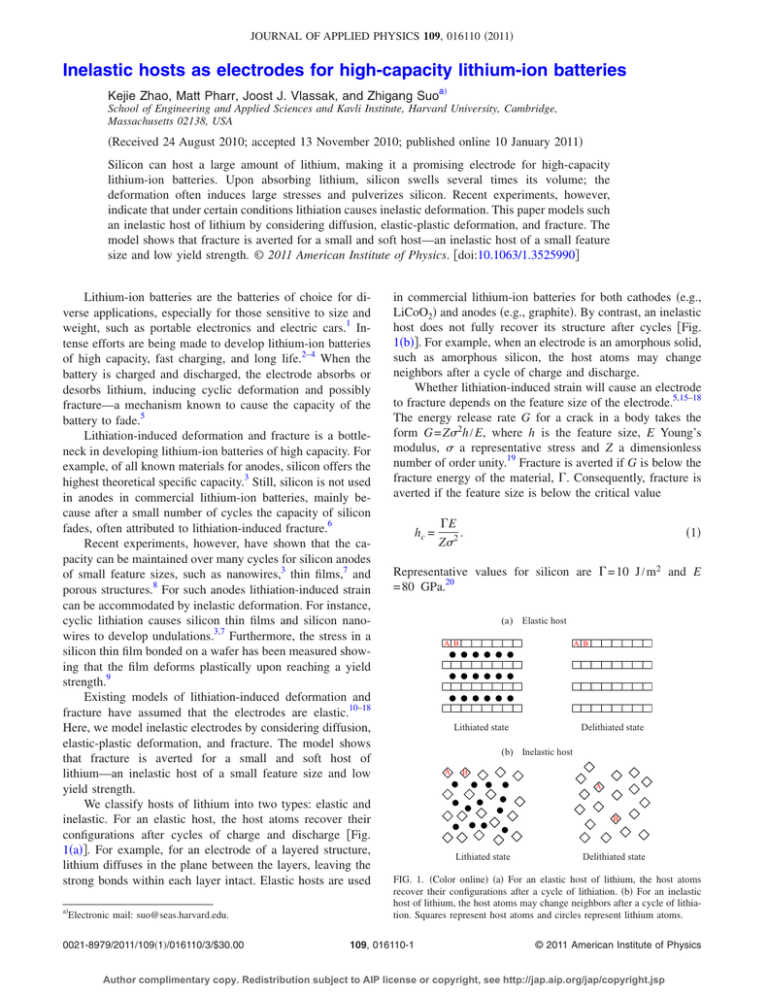
JOURNAL OF APPLIED PHYSICS 109, 016110 共2011兲 Inelastic hosts as electrodes for high-capacity lithium-ion batteries Kejie Zhao, Matt Pharr, Joost J. Vlassak, and Zhigang Suoa兲 School of Engineering and Applied Sciences and Kavli Institute, Harvard University, Cambridge, Massachusetts 02138, USA 共Received 24 August 2010; accepted 13 November 2010; published online 10 January 2011兲 Silicon can host a large amount of lithium, making it a promising electrode for high-capacity lithium-ion batteries. Upon absorbing lithium, silicon swells several times its volume; the deformation often induces large stresses and pulverizes silicon. Recent experiments, however, indicate that under certain conditions lithiation causes inelastic deformation. This paper models such an inelastic host of lithium by considering diffusion, elastic-plastic deformation, and fracture. The model shows that fracture is averted for a small and soft host—an inelastic host of a small feature size and low yield strength. © 2011 American Institute of Physics. 关doi:10.1063/1.3525990兴 Lithium-ion batteries are the batteries of choice for diverse applications, especially for those sensitive to size and weight, such as portable electronics and electric cars.1 Intense efforts are being made to develop lithium-ion batteries of high capacity, fast charging, and long life.2–4 When the battery is charged and discharged, the electrode absorbs or desorbs lithium, inducing cyclic deformation and possibly fracture—a mechanism known to cause the capacity of the battery to fade.5 Lithiation-induced deformation and fracture is a bottleneck in developing lithium-ion batteries of high capacity. For example, of all known materials for anodes, silicon offers the highest theoretical specific capacity.3 Still, silicon is not used in anodes in commercial lithium-ion batteries, mainly because after a small number of cycles the capacity of silicon fades, often attributed to lithiation-induced fracture.6 Recent experiments, however, have shown that the capacity can be maintained over many cycles for silicon anodes of small feature sizes, such as nanowires,3 thin films,7 and porous structures.8 For such anodes lithiation-induced strain can be accommodated by inelastic deformation. For instance, cyclic lithiation causes silicon thin films and silicon nanowires to develop undulations.3,7 Furthermore, the stress in a silicon thin film bonded on a wafer has been measured showing that the film deforms plastically upon reaching a yield strength.9 Existing models of lithiation-induced deformation and fracture have assumed that the electrodes are elastic.10–18 Here, we model inelastic electrodes by considering diffusion, elastic-plastic deformation, and fracture. The model shows that fracture is averted for a small and soft host of lithium—an inelastic host of a small feature size and low yield strength. We classify hosts of lithium into two types: elastic and inelastic. For an elastic host, the host atoms recover their configurations after cycles of charge and discharge 关Fig. 1共a兲兴. For example, for an electrode of a layered structure, lithium diffuses in the plane between the layers, leaving the strong bonds within each layer intact. Elastic hosts are used a兲 Electronic mail: suo@seas.harvard.edu. 0021-8979/2011/109共1兲/016110/3/$30.00 in commercial lithium-ion batteries for both cathodes 共e.g., LiCoO2兲 and anodes 共e.g., graphite兲. By contrast, an inelastic host does not fully recover its structure after cycles 关Fig. 1共b兲兴. For example, when an electrode is an amorphous solid, such as amorphous silicon, the host atoms may change neighbors after a cycle of charge and discharge. Whether lithiation-induced strain will cause an electrode to fracture depends on the feature size of the electrode.5,15–18 The energy release rate G for a crack in a body takes the form G = Z2h / E, where h is the feature size, E Young’s modulus, a representative stress and Z a dimensionless number of order unity.19 Fracture is averted if G is below the fracture energy of the material, ⌫. Consequently, fracture is averted if the feature size is below the critical value hc = ⌫E . Z2 共1兲 Representative values for silicon are ⌫ = 10 J / m2 and E = 80 GPa.20 (a) Elastic host A B A B Lithiated state Delithiated state (b) Inelastic host A B A B Lithiated state Delithiated state FIG. 1. 共Color online兲 共a兲 For an elastic host of lithium, the host atoms recover their configurations after a cycle of lithiation. 共b兲 For an inelastic host of lithium, the host atoms may change neighbors after a cycle of lithiation. Squares represent host atoms and circles represent lithium atoms. 109, 016110-1 © 2011 American Institute of Physics Author complimentary copy. Redistribution subject to AIP license or copyright, see http://jap.aip.org/jap/copyright.jsp 016110-2 J. Appl. Phys. 109, 016110 共2011兲 Zhao et al. If silicon were an elastic host, the lithiation-induced strain = 100% would cause stress on the order ⬃ E. Equation 共1兲 would predict a subatomic critical size.21 This prediction disagrees with the experimental observations— silicon anodes of feature sizes around 100 nm do survive many cycles of charge and discharge without fracture.3,7 By contrast, for an inelastic host, lithiation-induced strain can be accommodated by inelastic deformation, For a thin film of silicon bonded on a thick substrate, the measured yield strength is Y = 1.75 GPa.9 For a channel crack in the film, Z = 2 is a typical value.19 Using these values, Eq. 共1兲 predicts a critical thickness of 130 nm. This prediction agrees well with available experimental observations: a 250 nm silicon thin film fractured after a few cycles,22 while a 50 nm silicon film survived without fractures after 1000 cycles.7 In general, for an inelastic electrode of a large capacity, fracture is averted if the feature size is small and the yield strength is low. One extreme is a liquid electrode, which accommodates the absorption-induced strain by flow, and can potentially provide ultrahigh capacity.23 During charge and discharge, the stress in an electrode is a time-dependent field. Furthermore, the magnitude of the stress may exceed the yield strength at places under triaxial constraint. We describe an inelastic host of lithium by adapting an elastic and perfectly plastic model. The increment of the strain is taken to be the sum of three contributions 共2兲 dij = deij + dijp + dlij , where eij is the elastic strain, ijp the plastic strain, and lij the lithiation-induced strain. Hooke’s law gives deij = d 再 冎 1 关共1 + v兲ij − vkk␦ij兴 , E 共3兲 where is Poisson’s ratio. ␦ij = 1 when i = j and ␦ij = 0 otherwise. J2-flow rule gives dijp 冦 冧 e ⬍ Y = 0, e = Y , de ⬍ dY , sij , e = Y , de = dY 0, 共4兲 where sij = ij − kk␦ij / 3 is the deviatoric stress and e = 冑3sijsij / 2 the equivalent stress. Within the perfectly plastic model, at each increment is a positive scalar to be determined by the boundary-value problem. The lithiationinduced strain is proportional to the concentration of lithium dlij = d 冉 冊 c ␦ij , 3 共5兲 where  is a constant analogous to the coefficient of thermal expansion and c denotes the normalized lithium concentration in the host. The concentration of lithium in an electrode is a timedependent field, taken to be governed by the diffusion equation, c / t = Dⵜ2c. For simplicity, here, we assume that the diffusivity D is a constant and that diffusion is driven by the gradient of concentration alone. As an illustration of the model, consider a thin film of amorphous silicon bonded on a substrate. Let h be the thickness of the film, and the time used to complete charge or Y 0 Y 1 E c 3 1 v FIG. 2. Evolution of stress in a thin film of an inelastic host during cyclic lithiation and delithiation. discharge. We consider the limit h Ⰶ 冑D, where the film is so thin that the concentration of lithium is homogeneous throughout the thickness of the film. The stresses in the film are given by xx = yy = , zz = 0, where x and y represent the in-plane directions, and z represents the out-of-plane direction. The in-plane deformation of the thin film is constrained by the substrate, namely, dxx = dyy = 0. In the elastic stage, E d =− . dc 3共1 − v兲 共6兲 Figure 2 plots the stress evolution as a function of lithium concentration c. Initially, the film deforms elastically and develops a compressive stress, with the slope given by Eq. 共6兲. When the magnitude of compressive stress reaches the yield strength Y , the film deforms plastically. Upon delithiation, the film unloads elastically, develops a tensile stress, and then deforms plastically in tension. The fully lithiated state causes a volume expansion about 300%,6 so that  = 3. For v = 0.22.20 Equation 共6兲 gives the slope d / dc = −103 GPa, which may be compared to the measured value ⫺75 GPa in Ref. 9. In the thin film, the stress can be induced by the constraint imposed by the substrate. By contrast, a particle, a nanowire, or a porous structure is almost unconstrained by other materials, and the stress is mainly induced by the inhomogeneous distribution of lithium.24 Consequently, the stress is small when the feature size and charge rate are small.11,16,18,24 To explore the effect of inelastic deformation, we study the evolution of the stress field in a spherical particle of silicon. The particle is initiated as pure silicon, and is charged and discharged at a constant current. The dimensionless charge and discharge rate is set to be ina / DCmax = 0.206, where a is the radius of the particle, in is the current density for charge and discharge, and Cmax is the theoretical capacity of fully lithiated silicon. This dimensionless rate corresponds to in = 0.176 A / m2 for representative values a = 1 m, D = 1 ⫻ 10−16 m2 / s and Cmax = 8.52 9 ⫻ 10 Coulomb/ m3. Figure 3共a兲 and 3共b兲 show the distribution radial and hoop stresses during charge. As more lithium is inserted, the particle expands more near the surface than near the center, resulting in tensile radial stresses. The hoop stress is compressive near the surface and tensile near the center. For the Author complimentary copy. Redistribution subject to AIP license or copyright, see http://jap.aip.org/jap/copyright.jsp 016110-3 J. Appl. Phys. 109, 016110 共2011兲 Zhao et al. (a) 2.5 1.5 rr Y 1.0 0.5 0.0 rr Y 1.0 0.5 0.0 -1.0 -1.5 -2.0 -2.0 0.4 0.6 0.8 -2.5 0.0 1.0 r/a 2.5 0 .2 1.5 1.0 0.5 (d) 0.0 Dt/a 2 = 3.1 0.2 0.4 0.8 1.0 0.6 0.8 1.0 2.5 1.6 1.0 0.5 0.0 Y -0.5 Dt/a 2 0 1.65 -1.0 -1.0 -1.5 -1.5 -2.0 -2.0 Dt/a 2 = 3.1 -2.5 0.0 -2.5 0.0 0.2 0.2 0.6 1.5 0.1 0.02 -0.5 1.7 r/a 2.0 1.6 1.65 -0.5 -1.5 0.2 1.6 1.5 -1.0 2.0 Y 1.6 Dt/a 2 = 0 -0.5 2.5 2.0 0.1 0.02 -2.5 0.0 (b) (c) 0.2 2.0 0.4 0.6 0.8 1.0 1.7 0.4 r/a r/a FIG. 3. 共Color online兲 The evolution of 共a兲 radial stress and 共b兲 hoop stress during charge. The evolution of 共c兲 radial stress and 共d兲 hoop stress during discharge. spherical particle, the yield condition takes the form 兩 − rr兩 = Y . Due to the triaxial constraint at the center, the radial stress and hoop stress can exceed the yield strength. Also, large value of hydrostatic stress may cause an inelastic material to grow cavities. The lithium concentration at the surface reaches a value of unity at time Dt / a2 = 1.6. At this point, we reverse the electric current and start discharge. Figure 3共c兲 and 3共d兲 show the distribution of radial and hoop stress during discharge. As lithium desorbs, the radial stress evolves from tension to compression. Also, the hoop stress at the surface becomes tensile with magnitude Y . This tensile stress may result in the propagation of surface flaws. In summary, we have developed a model of an inelastic host of lithium by considering diffusion, elastic-plastic deformation, and fracture. For an electrode of a small feature size and low yield strength, inelastic deformation can prevent fracture. This work is supported by the National Science Foundation through Grant No. CMMI-1031161. Matt Pharr acknowledges the support of the Department of Defense through the National Defense Science & Engineering Graduate Fellowship Program. 1 G. A. Nazri and G. Pistoia, Lithium Batteries: Science and Technology 共Kluwer Academic, Boston, MA, 2003兲. 2 Department of Energy, Basic Research Needs for Electrical Energy Storage, 2007. 3 C. K. Chan, H. L. Peng, G. Liu, K. McIlwrath, X. F. Zhang, R. A. Hug- gins, and Y. Cui, Nat. Nanotechnol. 3, 31 共2008兲. B. Kang and G. Ceder, Nature 共London兲 458, 190 共2009兲. 5 R. A. Huggins and W. D. Nix, Ionics 6, 57 共2000兲. 6 L. Y. Beaulieu, K. W. Eberman, R. L. Turner, L. J. Krause, and J. R. Dahn, Electrochem. Solid-State Lett. 4, A137 共2001兲. 7 T. Takamura, S. Ohara, M. Uehara, J. Suzuki, and K. Sekine, J. Power Sources 129, 96 共2004兲. 8 H. Kim, B. Han, J. Choo, and J. Cho, Angew. Chem., Int. Ed. 47, 10151 共2008兲. 9 V. A. Sethuraman, M. J. Chon, M. Shimshak, V. Srinivasan, and P. R. Guduru, J. Power Sources 195, 5062 共2010兲. 10 R. Deshpande, Y. T. Cheng, and M. W. Verbrugge, J. Power Sources 195, 5081 共2010兲. 11 S. Golmon, K. Maute, S.-H. Lee, and M. L. Dunn, Appl. Phys. Lett. 97, 033111 共2010兲. 12 H. Haftbaradaran, H. J. Gao, and W. A. Curtin, Appl. Phys. Lett. 96, 091909 共2010兲. 13 X. C. Zhang, W. Shyy, and A. M. Sastry, J. Electrochem. Soc. 154, A910 共2007兲. 14 J. Christensen and J. Newman, J. Solid State Electrochem. 10, 293 共2006兲. 15 Y. H. Hu, X. H. Zhao, and Z. G. Suo, J. Mater. Res. 25, 1007 共2010兲. 16 T. K. Bhandakkar and H. J. Gao, Int. J. Solids Struct. 47, 1424 共2010兲. 17 K. E. Aifantis, S. A. Hackney, and J. P. Dempsey, J. Power Sources 165, 874 共2007兲. 18 W. H. Woodford, Y.-M. Chiang, and W. C. Carter, J. Electrochem. Soc. 157, A1052 共2010兲. 19 J. W. Hutchinson and Z. Suo, Adv. Appl. Mech. 29, 63 共1991兲. 20 L. B. Freund and S. Suresh, Thin Film Materials: Stress, Defect Formation and Surface Evolution 共Cambridge University Press, Cambridge, 2004兲. 21 J. Wolfenstine, J. Power Sources 79, 111 共1999兲. 22 J. P. Maranchi, A. F. Hepp, A. G. Evans, N. T. Nuhfer, and P. N. Kumta, J. Electrochem. Soc. 153, A1246 共2006兲. 23 D. C. Holzman, New Sci. 206, 19 共2010兲. 24 K. J. Zhao, M. Pharr, J. J. Vlassak, and Z. G. Suo, J. Appl. Phys. 108, 073517 共2010兲. 4 Author complimentary copy. Redistribution subject to AIP license or copyright, see http://jap.aip.org/jap/copyright.jsp
